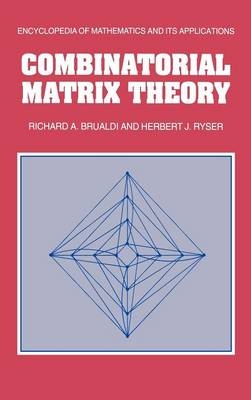
Combinatorial Matrix Theory
Seiten
1991
Cambridge University Press (Verlag)
978-0-521-32265-2 (ISBN)
Cambridge University Press (Verlag)
978-0-521-32265-2 (ISBN)
This book, first published in 1991, is devoted to the exposition of combinatorial matrix theory. This subject concerns itself with the use of matrix theory and linear algebra in proving results in combinatorics (and vice versa), and with the intrinsic properties of matrices viewed as arrays of numbers rather than algebraic objects in themselves. There are chapters dealing with the many connections between matrices, graphs, digraphs and bipartite graphs. The basic theory of network flows is developed in order to obtain existence theorems for matrices with prescribed combinatorial properties and to obtain various matrix decomposition theorems. Other chapters cover the permanent of a matrix, and Latin squares. The final chapter deals with algebraic characterizations of combinatorial properties and the use of combinatorial arguments in proving classical algebraic theorems, including the Cayley-Hamilton Theorem and the Jordan Canonical Form. The book is sufficiently self-contained for use as a graduate course text, but complete enough for a standard reference work on the basic theory. Thus it will be an essential purchase for combinatorialists, matrix theorists, and those numerical analysts working in numerical linear algebra.
1. Incidence matrices; 2. Matrices and graphs; 3. Matrices and digraphs; 4. Matrices and bigraphs; 5. Combinatorial matrix algebra; 6. Existence theorems for combinatorially constrained matrices; 7. Some special graphs; 8. The permanent; 9. Latin squares.
| Erscheint lt. Verlag | 26.7.1991 |
|---|---|
| Reihe/Serie | Encyclopedia of Mathematics and its Applications |
| Verlagsort | Cambridge |
| Sprache | englisch |
| Maße | 160 x 236 mm |
| Gewicht | 760 g |
| Themenwelt | Mathematik / Informatik ► Mathematik ► Algebra |
| ISBN-10 | 0-521-32265-0 / 0521322650 |
| ISBN-13 | 978-0-521-32265-2 / 9780521322652 |
| Zustand | Neuware |
| Informationen gemäß Produktsicherheitsverordnung (GPSR) | |
| Haben Sie eine Frage zum Produkt? |
Mehr entdecken
aus dem Bereich
aus dem Bereich
Buch | Softcover (2022)
Springer Spektrum (Verlag)
39,99 €


